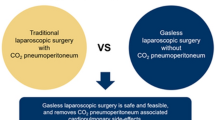Abstract.
Experimental studies demonstrated a severe cardiac load of the CO2 pneumoperitoneum caused by an accelerated after- and a decreased preload. Patients displaying cardiovascular risks are therefore often rejected from laparoscopic surgery. Hence, the pathophysiological changes and the intraoperative risk of the CO2 pneumoperitoneum in high-risk cardiopulmonary patients (NYHA II–III, n= 15) undergoing laparoscopic cholecystectomy are described. The changes in cardiac after- and preload seem to be due to the elevated intraabdominal pressure rather than transperitoneally resorbed CO2 and are reversible by desufflation. In one patient conversion to open operation had to be performed because of a severe drop in cardiac output and right ventricle ejection fraction. Mixed oxygen saturation was predicting intraoperative worsening in this case. The described pathophysiological changes may seem to be well tolerated even in high-risk cardiac patients. Monitoring of hemodynamics should include an arterial catheter line and blood gas analyses. Pharmacologic interventions or pressureless laparoscopic procedures might not be necessary as long as laparoscopic cholecystectomy is performed.
Similar content being viewed by others
Author information
Authors and Affiliations
Additional information
Received: 13 December 1996/Accepted: 8 January 1997
Rights and permissions
About this article
Cite this article
Gebhardt, H., Bautz, A., Ross, M. et al. Pathophysiological and clinical aspects of the CO2 pneumoperitoneum (CO2-PP). Surg Endosc 11, 864–867 (1997). https://doi.org/10.1007/s004649900473
Published:
Issue Date:
DOI: https://doi.org/10.1007/s004649900473




